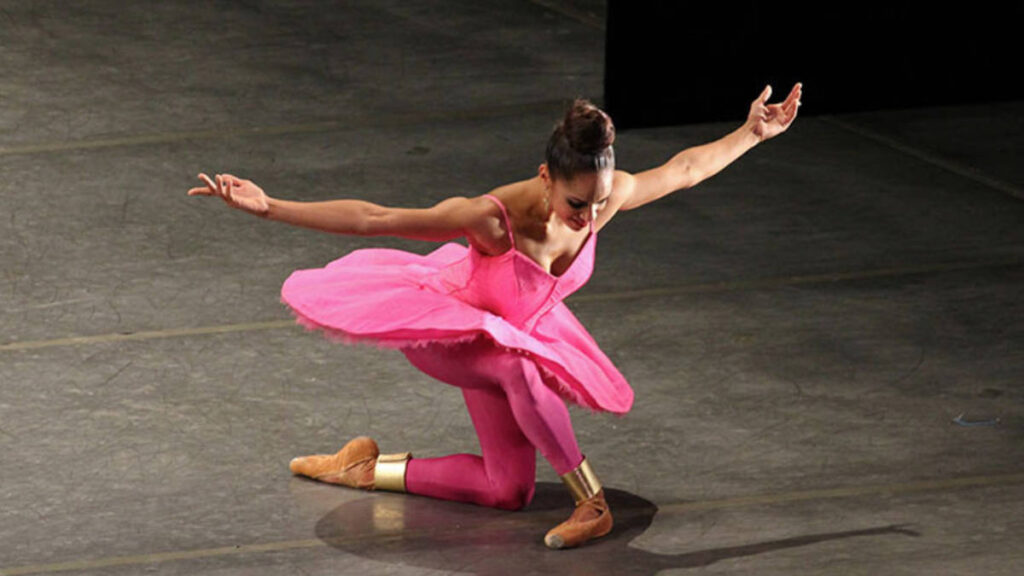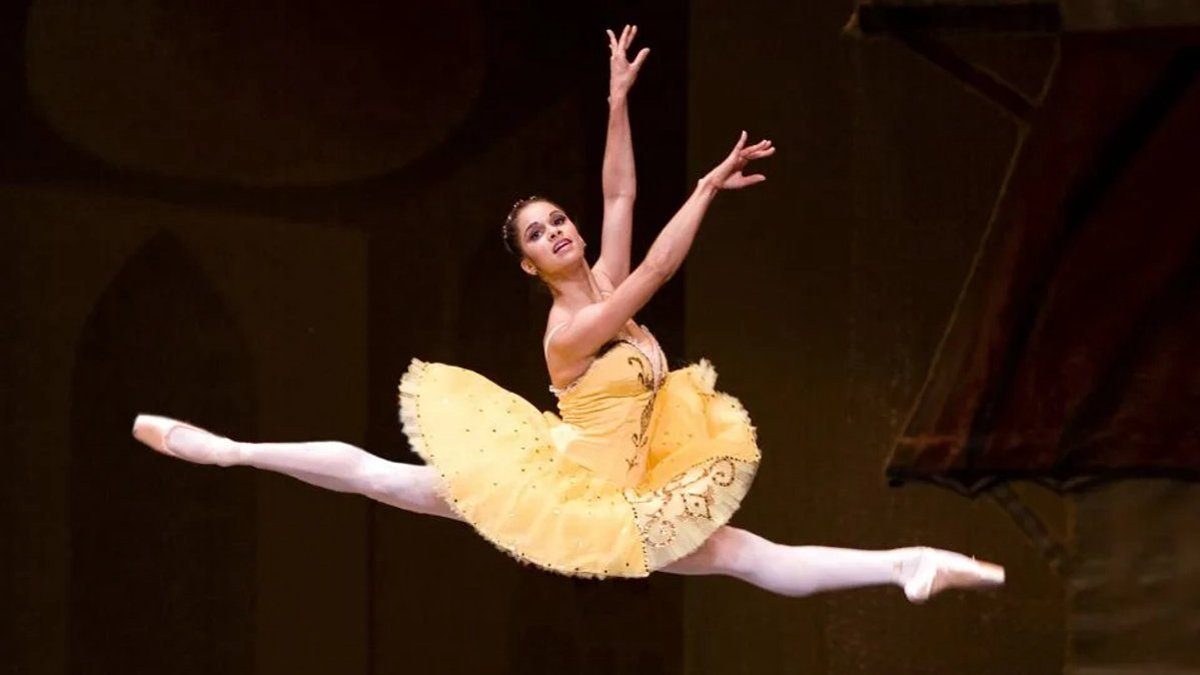Key Takeaways
- Misty Copeland’s final performance with American Ballet Theatre (ABT) turned Lincoln Center into a love letter to her 25-year legacy—complete with a free simulcast and hours-long lines.
- The 2015 history-maker took her last ABT bow at the David H. Koch Theater, returning after a five-year onstage pause; the gala drew a star-studded audience.
- Tickets soared on resale while ABT ensured access with community viewing—an inclusive gesture mirroring Copeland’s mission to open ballet’s doors.
- Copeland isn’t done dancing—she’s shifting her artistry into advocacy, education, and cultural leadership through her foundation and creative projects.
The plaza outside Lincoln Center hums like a heartbeat. The fall air is crisp, the kind that sharpens color and sound, and hundreds of fans snake around the campus, clutching programs, flowers, and phones.
Inside the David H. Koch Theater, a hush falls as Misty Copeland steps into the light. You feel it before you see it—the collective inhale for a ballerina who has been so much more than a dancer: a door-opener, a first, a forever.
Tonight, she isn’t just taking a final bow with American Ballet Theatre—she’s closing a chapter that redefined what ballet looks like, who it’s for, and how far grace can reach.
This is the end of one era and the beginning of another. Copeland’s last performance with ABT arrives in 2025 after a five-year onstage pause, a sold-out gala, and a free simulcast so the city could witness history together.
It’s emotional, inclusive, and very Misty: a celebration built for the community that built her. Ahead, we trace the arc of her rise, the electricity of her final night, and what her next act means for the art form she’s spent a career transforming.
Misty Copeland’s Final Performance—A Night New York Will Remember
At the David H. Koch Theater, Copeland’s farewell unfolds like a living scrapbook: a gallery of roles and relationships, of pas de deux that once felt impossible and now feel inevitable.
Celebrities, arts leaders, and longtime supporters—Oprah Winfrey among them—fill the house, while outside and next door, the crowd for the free simulcast stretches across Lincoln Center.
The city shows up because Copeland has always shown up: for ABT, for young dancers of color, for anyone who never saw themselves centered in classical ballet until she stepped into that center willingly, joyfully.
The sense of occasion is matched by demand: while official tickets were limited, secondary market listings soared, a testament to how rare this night is—but ABT’s decision to stream the performance free at Alice Tully Hall ensured the farewell wasn’t just for those who could afford a seat.
In ballet, access is often the biggest stage door; Copeland insisted it be open.
TMZ put it simply earlier in the day: the ballerina who returned to the stage after a five-year pause would close her ABT career at the fall gala—one last, luminous bow that is both “final” and “forever” in the same breath.
The Road to History—How a Late Starter Became Ballet’s Most Visible Pioneer
Copeland’s mythos begins with something ballet rarely grants: a late start. She took her first proper ballet class at 13, then leaped through ferocious work into a professional track.
In 2015, she shattered a reinforced ceiling when ABT named her its first Black female principal in the company’s 75-year history.
That sentence, repeated around the world, changed the texture of the art form; it said the quiet part out loud and then turned the spotlight on what could be.
But the title was only the beginning. Copeland’s visibility—commercial campaigns, bestselling books, a production banner, and a foundation focused on access—made her a rare thing: a ballerina who could command the culture outside the opera house and then walk back in without losing an ounce of classical authority.
As People reported in a summer feature, her 2025 retirement from ABT isn’t a goodbye to dance so much as a pivot to influence: a phase defined by mentoring, storytelling, and building pipelines so the next Misty doesn’t have to be a first.
The Farewell That Felt Like a Beginning—Inside the 2025 Gala’s Emotional Arc
New Yorkers understand a page-turning moment when they see one. They know the flutter in the lobby, the instant-classic ovations, the bouquets like small gardens.
They also know that endings here are really bridges. At the fall gala, Copeland moved through the repertory and relationships that shaped her artistry—partnered by longtime colleagues and honored by peers who know what it takes to stay extraordinary under a microscope.
The tribute crescendo—glitter, flowers, tears—felt less like punctuation and more like hyphenation: she’s linking everything she’s done to everything she’ll do next.
Outside, crowds at the simulcast made the plaza feel like a festival. Families. Students in dance school warm up. Elders who’d waited decades to witness someone who looked like them own this stage.
The feeling was civic. Historic. Proud. CBS New York captured the mood: hundreds queued for hours just to share space with the moment.
That’s the power of a dancer who refused to be singular—who insisted that ballet is bigger when more people are invited inside it.
What Made Misty Different—Technique, Theatricality, and the Story She Told With Her Body
To watch Copeland is to watch a story first, steps second. The technique is there—clean line, steel in the instep, balances that read as sentences—but it’s the meaning she layers over it that turns movement into memory.
As a principal, she understood the camera as well as the balcony, the advertisement as well as the adagio. She made ballet legible to people who had never purchased a ticket; then she made sure they could find one.
The AP’s coverage of her farewell underlined that point: Copeland’s career was never just about steps. It was about structural change—visibility that begets representation that begets opportunity.
Even in the moments of celebration, she acknowledged a tougher truth: the pipeline to principal for Black dancers remains too narrow. Her post-ABT work aims to widen it.
The City Showed Up—Celebrity Sightings, Viral Moments, and the Resale Market Buzz
As the house lights dimmed, the guest list glittered. Oprah Winfrey was among the luminaries who arrived to salute Copeland’s legacy, a sign of how far beyond the proscenium her influence travels.
Outside the hall, TikTok and Instagram fed on the spectacle—hairstyles, gowns, the procession of ballerinas past and present—and the resale market told its own story with prices topping four figures for a seat.
Yet the most telling image wasn’t velvet rope glamour; it was the queue for the free simulcast, proof that a classical art form can still feel like a citywide event.
Beyond the Bow—Motherhood, Mentorship, and the Misty Copeland Foundation
Copeland’s 2025 is not a retreat—it’s a reallocation. Through the Misty Copeland Foundation, she’s building programs that make ballet reachable for kids who’ve been told it isn’t for them.
It’s practical and poetic at once: scholarships, classes, and community work that lay new floorboards where the path used to end. People’s reporting this year noted that motherhood reshaped her pace and perspective; it also sharpened her purpose.
She’s dancing differently now—sometimes on a stage, often in rooms where policy, philanthropy, and arts education intersect.
The Culture Shift She Sparked—And Why It Matters in 2025
Zoom out from Lincoln Center, and you see a decade’s worth of ripple effects. Casting that looks like the city. School programs that don’t assume a tutu fits one body type, one complexion, one zip code.
Marketing images that finally diversify who sells pointe shoes and who buys them. Ballet has always contained universes; Copeland helped the mainstream notice.
The finale amplified that shift: ABT structured the night to be both exquisite and accessible, a stage and a screen. That duality—elegance with openness—is the new standard.

What She Leaves on the Stage—Roles, Reels, and a Record of Resilience
Some dancers are best remembered in a single role; Copeland collected eras. The lyrical dreaminess of “Romeo and Juliet.” The regal defiance of “Swan Lake.” Contemporary works that let her musicality bloom.
What ties them together is intention—every entrance carries a why. And every setback (injuries, scrutiny, the loneliness of being first) became raw material for a public story that gave other dancers courage.
Media outlets chronicled the farewell as both spectacle and syllabus: how a career of firsts can be taught in classrooms as a blueprint for systemic change.
That’s why the images of the night—flowers, glitter, ovations—don’t read as mere pageantry. They read as proof that excellence and equity can share center stage—and sell out the house.
Fans Built This, Too—How Community Turned a Farewell Into a Festival
If you wandered the simulcast crowd, you heard it: “I brought my daughter.” “I danced when I was a kid.” “We never thought we’d see this.” The community effect—those who felt seen because Copeland refused to shrink—turned a single performance into a public rite.
CBS New York’s coverage captured that civic joy: the lines, the selfies, the tears that come when someone else’s milestone makes your own life feel larger. That’s the mark of a cultural icon: the applause is personal.
What’s Next—Copeland’s Post-ABT Era
A farewell is a comma. Copeland has already hinted at what’s on the other side: more work through her foundation; new storytelling vehicles via her production company; continued advocacy in rooms where budgets and syllabi decide who gets access to art.
She has the rare leverage of mainstream fame and niche mastery—and she’s using it to redraw the map. As profiles this year emphasized, she’s leaving full-time company life, not the call to move. Expect collaboration, curation, and stages that don’t need velvet curtains to matter.
The Fashion and Confidence Evolution—From Studio Lines to Red-Carpet Armor
Ballet trains you to speak without a microphone; fashion hands you one. Over the years, Copeland’s style—sleek gowns, sculptural silhouettes, color with intention—became an extension of her thesis: I belong here.
On farewell night, the red-carpet ritual wasn’t about flash; it was about lineage. The look said: ballerina, businesswoman, builder. In 2025’s image economy, that clarity matters.
Little girls see it, and so do the donors who can underwrite the next scholarship. The costume changes, the message doesn’t.
Conclusion
Misty Copeland’s final performance with American Ballet Theatre wasn’t a door closing—it was a new corridor opening, lined with the faces of those who waited in the cold because they needed to be there when history took a bow.
She danced for the balcony and the block, for patrons in tuxedos and kids in sneakers, and she did it without apology or compromise. The ovation felt like a promise—New York will remember this night, and the field will keep reshaping around the example she set.
In the end, the phrase “Misty Copeland’s final performance” understates what happened. A ballerina finished a run; an architect kept building. And the city, for a few glittering hours, moved to her rhythm.
FAQs
When and where was Misty Copeland’s final performance with ABT?
October 22, 2025, at the David H. Koch Theatre at Lincoln Center in New York City, as part of ABT’s Fall Gala.
How big were the crowds—and was there a way to watch for free?
Hundreds waited in line for hours to attend a free simulcast at Lincoln Center’s Alice Tully Hall, which ABT hosted to expand access.
Why is Misty Copeland considered historic at ABT?
In 2015, she became the first Black female principal dancer in ABT’s 75-year history, a breakthrough that transformed visibility in ballet.
Did ticket prices spike for the farewell?
Yes—while official pricing varied, secondary market prices reportedly climbed into the thousands, reflecting intense demand.
Is Misty Copeland retiring from dance entirely?
No. She’s concluding her ABT performing chapter but continuing in dance through advocacy, education, and creative projects.
Who attended the gala?
A star-studded audience, including Oprah Winfrey, joined to honor Copeland’s legacy and celebrate her final ABT bow.
Why did this night matter beyond ballet?
It symbolized cultural change—expanding who sees themselves in classical art—and paired elite performance with public access via a free simulcast.
Mohit Wagh is the co-founder of The Graval with over 10 years of experience in SEO and content strategy. He specializes in crafting data-driven, authoritative content that blends cultural insight with digital growth.














